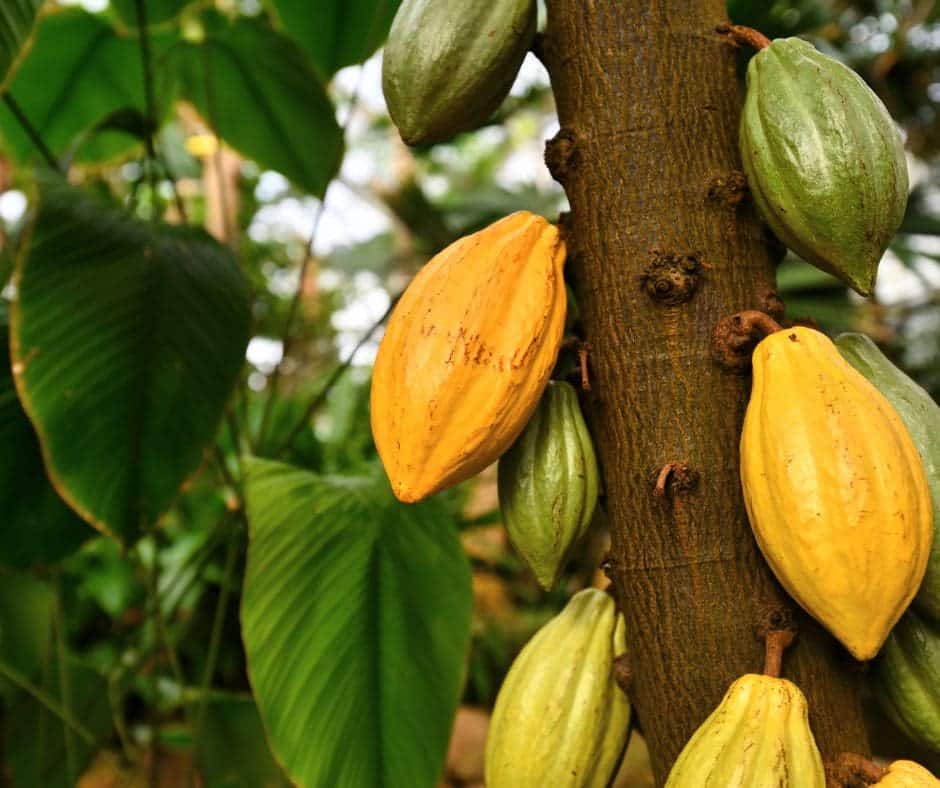Deep in the lush rainforests of Costa Rica, a treasure grows that has enchanted the world for centuries—cacao, the source of all chocolate. This small Central American nation is not just a biodiversity hotspot but also a significant player in the global chocolate industry, renowned for its rich, artisanal chocolate that comes with a host of health benefits.
The Cacao Plant
Cacao trees thrive under the canopy of dense rainforests, where the humid climate and rich soil provide the ideal growing conditions. In Costa Rica, cacao cultivation has deep roots in the indigenous cultures, historically used both as currency and ceremonial offerings. Today, the cacao plant continues to be a pillar of the agricultural sector, with farms primarily located in the Caribbean region, where the natural biodiversity protects the plants from pests and diseases. 
The cacao pod, brightly colored and football-shaped, contains seeds that are the raw product of chocolate. Once harvested, the seeds are fermented, dried, and roasted, transforming into familiar cocoa beans ready for processing.
Health Benefits of Cacao
Cacao is celebrated not only for its unique taste but also for its considerable health benefits. Rich in antioxidants, particularly flavonoids, raw cacao offers cardiovascular benefits, such as enhancing blood flow and reducing heart disease risk. It is also a mood enhancer, due to its theobromine content, which provides a gentle, long-lasting boost of energy without the harsh spike and crash typical of caffeine.
Moreover, cacao is a good source of minerals like magnesium, which aids in muscle relaxation and neurological function, and iron, which is crucial for transporting oxygen through the body. Regular consumption of high-quality dark chocolate with a high percentage of cacao is linked to various health benefits, including reduced inflammation and improved heart health.
Costa Rica’s Contribution to the Chocolate Industry
Costa Rica’s contribution to the chocolate industry extends beyond the mere production of cacao. It has carved a niche in the artisanal chocolate market, focusing on sustainable and ethically produced chocolate. Many Costa Rican chocolate producers adhere to organic practices, avoiding harmful pesticides and fertilizers to maintain the ecological balance and purity of their products.
This commitment to sustainability is evident in initiatives such as the Cacao Route, which offers tourists a firsthand look at traditional chocolate-making processes while promoting environmental stewardship. These artisanal practices not only preserve the cultural heritage of chocolate-making but also enhance the final product’s quality, making Costa Rica a key destination for chocolate connoisseurs worldwide. 
Exploring Chocolate Through Costa Rican Tours
Costa Rica offers a variety of tours that invite visitors to dive into the world of cacao and chocolate production. These educational excursions provide a comprehensive look at the journey from bean to bar, highlighting the intricate process of chocolate making. Tourists can visit cacao plantations, participate in chocolate-making workshops, and learn about the sustainable practices that define Costa Rican chocolate.
One popular tour is the “Chocolate Forest Experience” where visitors can walk through cacao groves, learn about the fermentation and drying processes, and enjoy tastings of different chocolate products. Another must-visit is the “Cacao Trails” in the Caribbean region, where the rich history of cacao in Costa Rican culture is showcased alongside modern artisanal chocolate production techniques.
These tours not only enhance the appreciation of chocolate but also support local communities and promote sustainable tourism practices.
Artisanal Value and Its Global Appeal
The artisanal value of Costa Rican chocolate lies in its small-batch production, which ensures greater control over the quality and flavor profile of the chocolate. This artisan approach often involves the entire community, from local farmers to skilled chocolatiers, fostering a sense of pride and craftsmanship that is palpable in every bite.
Costa Rican chocolate makers often experiment with infusions of local flavors such as coffee, coconut, and spices, offering a unique palette that distinguishes their chocolate on the global stage. This innovation, combined with a commitment to fair trade practices, ensures that the benefits of chocolate production reach all members of the supply chain, from the farmer to the final consumer.
The Healthiest Chocolate Choices for Consumers
For consumers interested in the health benefits of chocolate, dark chocolate with a cacao content of 70% or more is the best choice. These chocolates contain fewer sugars and fats compared to milk chocolates or those with lower cacao content, providing the maximum health benefits of cacao. Brands that ensure fair trade and organic certification add a layer of consumer trust, ensuring that the product is both health-conscious and ethically produced.
In Costa Rica, brands like Sibu and Nahua have gained international recognition, not only for their superior quality but also for their commitment to these ethical practices. These chocolates are not just treats but nourishing products that reflect the rich natural and cultural heritage of Costa Rica.
Costa Rica’s chocolate industry is a vibrant example of how environmental stewardship, combined with artisanal craftsmanship and community involvement, can create a product that






